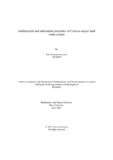| dc.contributor.advisor | Hossain, M. Mahboob | |
| dc.contributor.advisor | Ahmed, Akash | |
| dc.contributor.author | Subarna, Rifa Tamanna | |
| dc.date.accessioned | 2023-12-12T06:36:07Z | |
| dc.date.available | 2023-12-12T06:36:07Z | |
| dc.date.copyright | 2023 | |
| dc.date.issued | 2023-06 | |
| dc.identifier.other | ID 19126019 | |
| dc.identifier.uri | http://hdl.handle.net/10361/21968 | |
| dc.description | This thesis is submitted in partial fulfillment of the requirements for the degree of Bachelor of Science in Microbiology, 2023. | en_US |
| dc.description | Catalogued from PDF version of thesis. | |
| dc.description | Includes bibliographical references (pages 28-31). | |
| dc.description.abstract | Chemical compounds derived from plants have been used to treat several diseases all over the world since the dawn of human civilization. Many of the drugs that are currently on the market have either been directly or indirectly produced from plants, which have historically been an excellent source of pharmaceuticals. Bangladesh is home to a significant medicinal plant: Crateva magna. The plant Crateva magna is locally known as “Borun”. The anti-inflammatory capabilities of this plant are well known. Numerous pharmacological properties have been reported for C.magna as well as several traditional uses that need to be thoroughly scientifically examined. The work in this thesis project details the antioxidant and antibacterial activity of one species of Crateva. Not enough work had been reported previously on this species and this species is grown in Bangladesh and has not been studied extensively so far. The bark of Crateva magna was extracted with dichloromethane and methanol, then subjected to partition, followed by thin-layer chromatography. In addition, an antioxidant test and antibacterial test were performed. Chloroform and ethyl acetate partition extract showed mild antibacterial activity. However, chloroform, ethyl acetate, methanol, and hexane partition extract showed up to 70.96%, 74.75%, 56.16%, and 33% of free radical inhibition activities respectively. Visualizing the TLC plate exhibits that several compounds are present in the chloroform, ethyl acetate, and hexane part. Hence, the findings of this project work encourage further research to use this plant for therapeutic purposes. | en_US |
| dc.description.statementofresponsibility | Rifa Tamanna Subarna | |
| dc.format.extent | 31 pages | |
| dc.language.iso | en | en_US |
| dc.publisher | Brac University | en_US |
| dc.rights | Brac University theses are protected by copyright. They may be viewed from this source for any purpose, but reproduction or distribution in any format is prohibited without written permission. | |
| dc.subject | Crateva magna | en_US |
| dc.subject | Antioxidant | en_US |
| dc.subject | Antibacterial | en_US |
| dc.subject | Thin layer chromatography | en_US |
| dc.subject | Dichloromethane | en_US |
| dc.subject | Methanol | en_US |
| dc.subject.lcsh | Drug resistance in microorganisms | |
| dc.title | Antibacterial and antioxidant properties of Crateva magna bark crude extract | en_US |
| dc.type | Thesis | en_US |
| dc.contributor.department | Department of Mathematics and Natural Sciences, Brac University | |
| dc.description.degree | B. Microbiology | |

